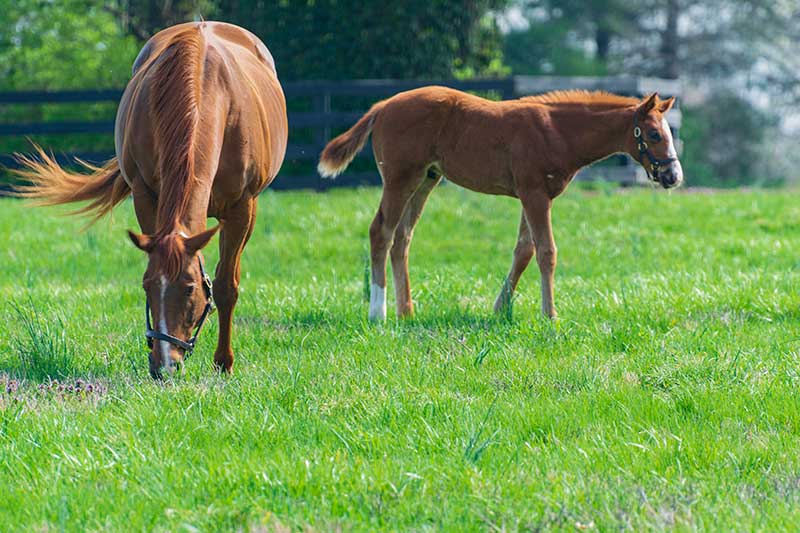Breeding Mares Early in Life Might Lead to Early Fertility Decline

According to a new study in Japanese racehorses, broodmare fertility appears to decrease slowly over the years, on a downhill slope that follows her number of breeding years—and not just her age.
“Our results suggest that the fertility of a mare is the highest at (her) first year breeding and gradually declines every year,” said Jeffrey Fawcett, PhD, a biologist and senior research scientist at RIKEN Interdisciplinary Theoretical and Mathematical Sciences Program (iTHEMS), in Saitama, Japan.
“It is not like the mare is fertile until a certain age and then starts to become barren,” Fawcett said. “It is a gradual decline right from the start, rather than a sudden decline at a certain age—although we don’t know what the exact biological cause is.”
Fawcett teamed up with Fumio Sato, PhD, of Japan Racing Association’s Equine Research Institute in Tochigi, and researchers from two other Japanese institutions to investigate the links between broodmare age, reproductive performance, and offspring racing performance.
They examined the records of all 364,724 breeding attempts in Thoroughbreds throughout Japan between 1997 and 2017 and traced outcomes of the foals produced from those attempts.
They found all mares had reduced fertility as they aged—meaning they were gradually less likely to get pregnant and give birth to a live foal with each successive year, Sato said.
This was not a matter of age alone, he said. It also had to do with how long the mare had been breeding. Specifically, the earlier a broodmare started breeding in her lifetime, the sooner that gradual decline in fertility began.
“Perhaps rather surprisingly, we found that the rate starts declining right after the first mating,” said Fawcett. “For example, 4-year-old mares being bred for the first time have higher birth rates than 4-year-old mares that were already bred when they were 3 years old. Likewise … 5-year-old mares that started breeding when they were 4 years old have higher birth rates than 5-year-old mares that started breeding when they were 3 years old.”
Whether that’s due to repetitive foalings is unclear, he said. Records don’t always indicate whether breeders rebred mares year after year. “Perhaps it’s every year she’s bred or every foal she births; we’re not sure,” Fawcett said.
Performance Success of Foals From Older Mares: A Selection Bias?
Some foals from older mares can have good earnings on the racecourse, said Sato.
But that finding might be misleading due to what scientists call a “selection bias,” he said. In reality, if all the mares continued to be bred into their senior years, we’d likely see significantly fewer foals produced per breeding attempt and significantly fewer earnings on the track.
Many of the mares that start breeding late (around age 6 or 7, for example) are those that had successful racing careers and, therefore, often pass on their good qualities to their foals, the researchers said. But that’s only a minor part of the bias.
“Older mares are less likely to produce high-quality foals—although it doesn’t mean that they never do, but just that they are less likely to,” explained Fawcett.
Often, the only mares still producing at an old age are the ones that had produced high-quality foals in the past, he said. As older mares, they might still produce good-quality foals, but performance results of the offspring decline significantly compared to those produced in her earlier years.
“More importantly, we find that mares that are bred until they are old are mares with high fertility that have produced high-quality foals when they were young,” he continued. “When this bias is considered, the decline in the fertility and racing ability of the foals becomes much larger.”
Such a bias suggests the decline in foal quality from older mares might be greater than previously thought, he added.
“The decline in fertility and ability to produce high-quality foals has been underestimated in previous studies because old mares being mated are heavily biased toward elite mares,” Fawcett said.
“And while it may seem that ‘elite’ mares are still somewhat capable when they are old, they were in fact much, much more capable (at least on average) when they were young,” he said. “And the decline is quite large.”
The study, “Effect of advancing age on the reproductive performance of Japanese Thoroughbred broodmares,” was published by the Journal of Equine Science on June 18, 2021.

Written by:
Christa Lesté-Lasserre, MA
Related Articles
Stay on top of the most recent Horse Health news with















